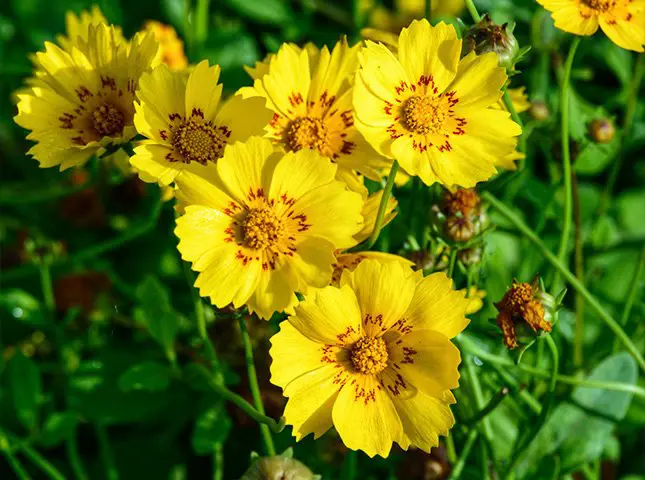Coreopsis, or tickseed, is generally considered deer-resistant due to its unpalatable taste and rough texture.
Deer are selective eaters, preferring moisture-rich plants with softer foliage. Coreopsis’s drought tolerance and strong scent further deter deer browsing.
However, no plant is entirely deer-proof, and feeding habits can vary based on factors like food scarcity and seasonal changes. While coreopsis remains a low-risk option for deer-prone gardens, it’s wise to employ additional protection strategies during high-risk periods.
Companion planting with other deer-resistant species and using physical barriers can enhance your garden’s defense.
Table of Contents
Understanding Deer Feeding Habits
Understanding deer feeding habits is essential when planning a garden that can coexist with local wildlife. Deer are selective eaters, often choosing plants based on taste, texture, and moisture content.
When considering deer resistant plants, coreopsis stands out as an excellent option. This flower’s unappealing taste and rough texture make it less attractive to deer, especially when alternative food sources are available.
Coreopsis’s drought tolerant nature contributes to its deer-resistant qualities. As deer often seek moisture-rich plants, the ability of coreopsis to thrive in dry conditions makes it less appealing to these foragers. Additionally, the prolonged blooming period of coreopsis attracts beneficial pollinators without enticing deer, who prefer softer, more palatable foliage.
In areas with high deer populations, incorporating coreopsis into your garden design can help maintain aesthetic appeal while minimizing damage from deer feeding habits. By understanding that deer generally avoid coreopsis due to its bitter flavor and coarse texture, you can strategically plan your garden to include this resilient plant.
This approach allows you to create a visually pleasing landscape that’s less likely to become a deer’s buffet, effectively balancing horticultural beauty with practical wildlife management.
Coreopsis Characteristics and Deer Resistance
Coreopsis stands out as a prime example of a deer-resistant plant, boasting characteristics that make it unappealing to these persistent grazers. This perennial, commonly known as tickseed, features bright yellow flowers that are visually striking but unpalatable to deer. The plant’s narrow green leaves and vibrant blooms enhance garden aesthetics while effectively deterring unwanted browsing.
You’ll find that coreopsis thrives in well-drained soil and prefers full sun exposure, making it an ideal choice for low-maintenance gardens. Its drought-tolerant nature further contributes to its ease of care, as it can withstand periods of neglect. Hardy in USDA zones 3-9, coreopsis adapts well to various climates, offering a long-lasting solution to deer-related garden issues.
Beyond its deer-resistant qualities, coreopsis attracts pollinators such as butterflies and bees, promoting biodiversity in your garden. The plant’s extended blooming period guarantees a continuous display of cheerful flowers throughout the growing season.
Factors Affecting Deer Plant Preferences
When it comes to deer plant preferences, several key factors influence their browsing habits and can determine whether they’ll target coreopsis in your garden. The unappealing taste and texture of coreopsis make it a deer-resistant plant, often leading deer to seek out more palatable options.
You’ll find that the availability of alternative food sources plays an essential role in shaping deer feeding habits, potentially steering them away from coreopsis when more appealing choices are present.
Coreopsis’s drought tolerance and low maintenance requirements make it an attractive option for gardeners in areas with high deer populations. These characteristics allow the plant to thrive with minimal care, reducing the likelihood of deer damage.
Seasonal changes can affect deer plant preferences, but coreopsis generally remains unappealing throughout the growing season. Additionally, the strong scent emitted by some coreopsis varieties may further deter deer, as they typically avoid plants with pungent fragrances.
Coreopsis Species and Deer Palatability
Nearly all species of Coreopsis share a remarkably low palatability to deer, making them an excellent choice for gardeners in deer-prone areas. This deer-resistant characteristic is attributed to the plant’s unappealing taste and texture, which consistently deters these herbivores across various Coreopsis species. As a result, you can confidently select from a wide range of Coreopsis varieties without compromising on deer resistance.
Coreopsis thrives in drought conditions, further reducing its attractiveness to deer that typically prefer more succulent vegetation. This adaptability to dry environments, coupled with its low-maintenance nature, makes Coreopsis an ideal perennial for gardens in regions with high deer populations.
The plant’s extended blooming period, from late spring to early fall, provides a lasting visual appeal while remaining largely untouched by deer. Additionally, these vibrant blooms attract beneficial pollinators such as butterflies, enhancing your garden’s ecological value.
Alternative Plants Deer Favor
Understanding deer’s preferred plants can help you protect your garden and guide your landscaping choices. While deer tend to avoid certain species like coreopsis, they’re drawn to plants with high water content and softer foliage.
Unlike the deer-resistant coreopsis, which attracts butterflies but deters deer with its rough textures, many perennial flowers and annuals become favorite plants for these browsers. Deer often target hostas, tulips, and young fruit trees, finding them more palatable than tougher varieties.
They’re particularly fond of sweeter options like clover and alfalfa, especially when food is scarce. During spring, when new growth abounds, deer may be more likely to sample a wider range of plants. However, they generally prefer tender leaves over spiny or tough foliage.
To protect your garden, consider incorporating more deer-resistant options alongside your vulnerable plants. While coreopsis and similar species with unappealing tastes can help deter deer, it’s important to remember that in times of scarcity, even these plants may not be entirely safe.
Diversifying your garden with a mix of deer-resistant and preferred plants can create a balanced landscape that satisfies both your aesthetic preferences and the local wildlife.
Deterrent Methods for Garden Protection
To ward off deer effectively, you’ll need to employ a variety of deterrent methods alongside planting deer-resistant species like Coreopsis. While Coreopsis’s strong fragrance and unappealing taste naturally repel deer, combining these inherent qualities with additional protective measures can greatly enhance your garden’s defense against browsing.
Consider implementing physical barriers such as fencing or netting around your garden. These obstacles can deter deer from accessing your plants, especially when food sources are scarce.
Companion planting is another effective strategy; pair Coreopsis with other deer-resistant plants to create a more robust defense system. This approach not only diversifies your garden but also reinforces its overall resistance to deer.
To prevent deer from becoming accustomed to your deterrent methods, regularly rotate your tactics. Incorporate visual or audio scare devices to supplement the natural repellent properties of Coreopsis.
Landscaping Strategies With Coreopsis
Beyond its role in deterring deer, Coreopsis offers a wealth of landscaping possibilities that can transform your garden into a vibrant, low-maintenance oasis.
This perennial flower thrives in full sun and well-draining soil, making it an ideal choice for various garden designs. When planning your landscape, consider grouping 3-5 Coreopsis plants together to create visually striking masses that will attract butterflies and other pollinators.
Incorporate Coreopsis into mixed perennial borders for a cheerful contrast against bold-textured foliage plants. This strategy adds depth and interest to your garden while maintaining a cohesive design. To guarantee continuous blooming throughout summer, implement regular deadheading of spent flowers. This practice not only promotes vibrant blooms but also keeps your garden looking tidy and well-maintained.
As deer dislike the taste of Coreopsis, you can confidently use it as a key element in your landscaping strategies. Its drought tolerance and low maintenance requirements make it an excellent choice for busy gardeners or those seeking to reduce water consumption.
Companion Planting for Deer Management
By strategically pairing Coreopsis with other deer-resistant plants, you’ll create a robust defense against unwanted browsing while enhancing your garden’s beauty and biodiversity. Companion planting is an effective technique that leverages the natural characteristics of various species to deter deer and promote a healthier garden ecosystem.
Consider incorporating aromatic herbs like lavender or sage alongside your Coreopsis. These strongly scented plants act as a natural repellent, making your garden less appealing to deer. Additionally, grouping Coreopsis with other drought-tolerant plants, such as Echinacea or Yarrow, can maintain aesthetic appeal while minimizing deer attraction.
Implementing a diverse planting strategy that includes both flowering plants and ground covers will further reduce deer access and promote overall plant health.
To maximize the effectiveness of your companion planting efforts, regularly rotate your plant selections. This practice prevents deer from becoming accustomed to specific arrangements, enhancing the deterrent effect over time.
Seasonal Considerations for Coreopsis Protection
While Coreopsis is generally deer-resistant, you’ll need to adapt your protection strategies throughout the year to secure its safety from seasonal browsing pressures.
Late winter and early spring pose the greatest risk, as food sources become scarce and deer may resort to foraging on less preferred plants. During this time, increase your monitoring efforts to detect any signs of deer activity near your Coreopsis.
As late spring arrives and your Coreopsis bursts into bloom, you can expect less pressure from deer. However, don’t let your guard down completely. Continue deadheading throughout the growing season to maintain the plant’s vigor and resilience against potential browsing. This practice not only encourages more flowers but also helps sustain the plant’s deer-resistant properties.
In preparation for the colder months, apply a layer of mulch around your Coreopsis in late fall. This serves a dual purpose: it helps retain soil moisture and creates a well-maintained appearance that deer tend to avoid.
Frequently Asked Questions
Is a Coreopsis Deer Resistant?
Yes, coreopsis is deer-resistant. You’ll find it’s an excellent choice for your garden if you’re dealing with deer problems. It’s unappealing to them due to its taste, texture, and strong scent. It’s also hardy and drought-tolerant.
Do Deer and Rabbits Eat Coreopsis?
You’ll be pleased to know that deer generally don’t eat Coreopsis due to its unappealing taste. While rabbits might occasionally nibble on it, it’s not their preferred food source either. Your Coreopsis plants should remain largely untouched by both.
What Is the Most Deer-Resistant Flower?
You’ll find Lavender and Salvia among the most deer-resistant flowers. Their strong scents repel deer effectively. Echinacea, Yarrow, Russian Sage, and Catmint are also excellent choices, thanks to their aromatic properties and tough foliage.
What Animal Is Eating My Coreopsis?
You’re likely dealing with rabbits or insects, not deer. Check for small bite marks or chewed leaves. Look for signs of snails, slugs, or caterpillars. Consider setting up a wildlife camera to catch the culprit in action.
Conclusion
While coreopsis is generally considered deer-resistant, you’ll find that deer may still browse on these plants if other food sources are scarce.
You’ve learned that factors like local deer populations, available alternatives, and specific coreopsis varieties can influence deer’s interest in your garden.
By implementing a combination of deterrent methods, strategic landscaping, and companion planting, you’ll increase your chances of protecting your coreopsis.
Remember to adapt your approach seasonally, as deer’s feeding habits change throughout the year.


